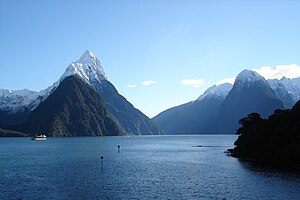 |
| New Zealand's Milford Sound (Wikipedia) |
In Australia, Queensland and New South Wales will soon have a “one stop shop” for environmental approvals and assessment, including a 12-month limit on the assessment process.
The reforms, according to environment minister Greg Hunt, are a step towards the environmental approval process in New Zealand, which Hunt has called “one of the best systems in the world”.
But evidence from across the Tasman Sea shows Australia shouldn’t be leaping to emulate its neighbour.
How does New Zealand’s environmental assessment work?
New Zealand’s key environmental planning legislation is the Resource Management Act. The key difference with other environmental legislation around the world is that New Zealand has made environmental impact assessment an integral part of the whole planning and approval process.
In Australia the process is different. Environmental impact is assessed separately under a different piece of legislation, the Environment Protection and Biodiversity Conservation Act. The rationale for keeping assessment in one place was reducing the scope for government intervention.
The Resource Management Act was internationally lauded at its inception in 1991, thanks to this inclusion. It was seen as very progressive, achieving a difficult balance between economic development and environmental protection.
But 20 years on from the creation of the Resource Management Act, reforms are threatening its world-class status.
Right from the start resource management faced substantial opposition from landowners and resource developers, who saw the act as constraining private property rights, and imposing unreasonable costs and delays.
The Resource Management Act was seen as an unnecessary and inappropriate intervention in markets.
This is despite good environmental outcomes benefiting businesses. Environmental protection such as that provided in the Resource Management Act underpinned New Zealand’s “100% Pure NZ” tourism brand.
In 2008 a centre-right National-led government was elected, significantly boosting the campaign against the Resource Management Act. The incoming government made resource management reform a key priority for the “first 100 days”.
The reforms included the creation of a new national approval process. A new agency, the Environmental Protection Authority, was created to oversee the process.
Key among the changes was a nine-month limit on environmental approvals. In the past three years a growing number of projects have been pushed through these streamlined approvals.
The overall aim is to facilitate resource development including new onshore and offshore, oil and mineral wealth exploitation. Any project deemed to be of national significance can be subject to the streamlined approvals process.
To date, these have included road building, aquaculture industry expansion, and water storage (for the booming dairy industry in particular).
What do these changes mean for us?
Fast-tracking and streamlining environmental approvals undermines the role of communities in environmental decision-making. The reforms sharply curtail scope for public participation.
The very tight timeframe, costs of participation and the highly formal quasi-judicial processes used are among many aspects of the national consenting processes that are daunting and discouraging for public submissions.
Research shows that the public’s views tend to have much less weight than other stakeholders.
Recently an association of highly respected independent environmental law specialists took the unprecedented step of publicly raising “serious and compelling concerns” about the reforms. According to these experts:
It is a process that seems designed to facilitate the applicant getting consents and the plan change getting approved unchanged. It is a process that appears designed to implement the government’s growth agenda at all costs - and to ride roughshod over serious and legitimate public interest and environmental concerns.In the past New Zealand’s integrated resource management and environmental assessment could have been held as an example for other environmental approvals. But now New Zealand needs much more scrutiny, especially before the model is exported overseas.
Christine Cheyne does not work for, consult to, own shares in or receive funding from any company or organisation that would benefit from this article, and has no relevant affiliations.
This article was originally published at The Conversation. Read the original article.

No comments:
Post a Comment